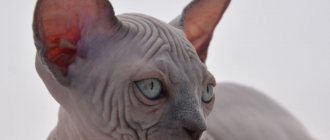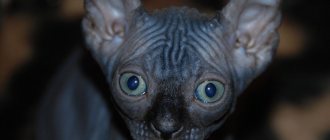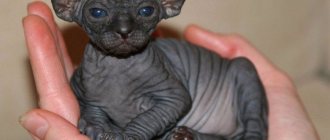For cats, the organ of hearing and the preservation of its functions are extremely important. Cats not only hear an order of magnitude better than humans. With the help of their hearing, these animals are well oriented in the environment, having the ability to determine the source of sound and its location. The quality of a cat’s hunting also depends on this skill, because she perfectly hears the squeaking of mice and the rustling of lizards.
Keep in mind that increased production of sulfur is characteristic of breeds with large ears (Savannah, Abyssinian and Somali cats), as well as breeds with minimal fur (Sphynx, Peterbald, Rex).
How difficult is it to care for a Sphynx?
Unlike cats with coats, hairless cats require more careful and frequent grooming. If you don’t take care of your Sphynx’s skin, the animal can develop fungal diseases, which can sometimes take a long time and be difficult to treat.
It's all about the large amount of fat secreted by the skin of sphinxes. Dirt sticks to the greasy film covering the cat's body, and it all rolls into the folds of the skin, where pathogenic bacteria successfully multiply. And if this dirt is not washed off periodically, then inflammation of the skin begins with all the ensuing consequences (fungal diseases, ulcers, etc.). This is why hairless cats are recommended to be washed at least once a week or wiped with hypoallergenic wet wipes for sensitive skin or with aloe vera. Too much oil production may indicate that the cat is not eating properly (for example, too much fatty food in the diet) or that the cat is not feeling well. Sphynx cats have no (or very little) hair in their ears, which makes them more prone to collecting dirt. Sphynx ears also produce large amounts of earwax. Mixing with dirt and clogging the ear canals, excess wax prevents the ear from “breathing” and the development of otitis media begins. If this condition is not noticed in time, then external otitis may develop into internal, which is especially dangerous, since the cat may lose hearing, or even worse.
Examination of the animal before the procedure
Preventative examination of the ears of kittens and adult sphinxes is necessary weekly, the best time is before bathing. This procedure will help determine signs of otitis media and other diseases.
The inspection process involves the following sequence of actions:
- Place the kitten on a flat surface near a source of good lighting.
- Fix the animal's head by lightly pressing it.
- Turn the ear out, avoiding sudden movements, so as not to scare the cat.
If you observe a serous composition with a light brown paste consistency, evenly distributed inside the sink, this is normal. The discharge should not have any unpleasant odors, signs of pus or foreign matter in the form of liquid or ichor. The Sphynx's ear should be neat, with no signs of scratching that would be a cause for concern.
What should you be wary of?
The presence of a large amount of serous secretion compared to previous examinations and cleaning indicates changes in the animal’s body. The presence of the following signs will be important:
- Changes in the volume and color of the released sulfur; with the development of otodectosis, it will change color to dark brown.
- The leakage of fluid, the appearance of greenish crusts and an unpleasant odor, which may be a sign of purulent otitis media.
- Your cat scratching the surface of his ears will be a sign of irritation and bothersome itching caused by inflammation of the ear canal.
- If a Sphynx cat behaves restlessly, shakes its head, sleeps poorly, this is also a sign of diseases that affect the ear canals and the ear as a whole - allergies, inflammation and metabolic disorders.
If there is not enough serous fluid secreted, and the ears show signs of dryness and flaking, this indicates a low fat content in the diet.
Important! Cleaning the ears in the presence of purulent otitis is prohibited; for this it is better to seek qualified help from a veterinarian.
How often and with what should you wash your Sphynx?
As stated above, Sphynx cats need to be washed at least once a week. If this is not possible, then wipe the animal with damp baby wipes (or special wipes for animals). Particular attention is paid to the folds on the muzzle and the places between the toes.
For washing, use shampoos designed specifically for hairless cats. From reviews of Sphynx owners, they use a variety of means for bathing. Here are some of them: Bayer HyLyt® Shampoo, Organic Pet Shampoo Sphynx Cat, Malaseb Pet Shampoo (medicated shampoo with an antifungal effect, helps treat any fungal or bacterial diseases, preferably used only as needed), Allerpet Cat Dander Remover, Zymox Shampoo, Alba Botanica Natural Hawaiian Coconut Shampoo and Conditioner, Earthbath All Natural Hypo-Allergenic and Fragrance Free Cat Wipes.
Some Sphynxes are unnerved by the sound of running water, so it is better to pour water into the bath in advance. Place a mat on the bottom of the bath (to prevent the cat from slipping its paws) and fill with warm water. The water level should be up to the cat's stomach. Prepare a dry towel. Gently place the cat in the bath. Lather your pet, paying special attention to the belly, back of the legs and between the toes. Do not wet your head, but wipe it with a damp sponge. Then rinse your Sphynx and wrap him in a towel. After the bath, some breeders recommend applying a shea butter-based body butter or lotion to the skin.
Sphynx hygiene
Due to their high metabolism, Sphynx cats get dirty quickly. The skin becomes covered with a greasy dark brown coating. They need to be bathed periodically. They ask, “Isn’t it harmful to bathe the Sphinx often?” I answer - yes, it is harmful, but walking dirty for the sphinx is even more harmful. In the summer I bathe them every week, in the winter less often - as they get dirty. I bathe the black ones once a month - for some reason they get dirty less, or the dirt is simply not visible on them! If your Sphynx gets dirty faster than a week after bathing, change his diet - the current one is not suitable for him! It's been a long time since Friday is a bath day at the nursery. I don’t wash everyone, but I clean everyone’s ears, claws and eyes. I begin these weekly hygiene procedures almost from the moment the babies are born. Every day I wipe my babies with a damp sanitary napkin. I bathe him in a basin for the first time before the first vaccination at 2 months. The main thing is not to scare the baby: all procedures are performed smoothly and slowly. The water does not make noise, the hair dryer does not turn on. I am calmness itself... it is necessary, it means it is necessary.... I talk to the little sfinson affectionately, clearly explaining that “shame and shame on unclean chimney sweeps!” By the age of 3.5 months, kittens can easily tolerate all hygiene procedures. Many simply stoically tolerate them, but there have also been “waterfowl” in the nursery.
Please note that you need to pour a lot of water into the basin - up to the animal’s chin when it sits on its butt. The water temperature is 38 degrees - moderately warm, so that your hand feels pleasantly warm. Beat a small amount of neutral shampoo into foam in advance. I use a special shampoo for sphinxes (or for hairless animals) “Elite”; you can also use baby shampoo (without perfume).
We lower the sphinx into the basin, holding it by the hind legs and scruff of the neck. Wash with a soft sponge, starting from the back, then in turn each pad on the paws, tummy, butt and tail. We don’t wash our hair and try to prevent water from getting into our ears. Then we transfer the sphinx to another previously prepared container with clean warm water, rinse it and pour it on top from a plastic ladle. Using the same ladle, we wash the face by hand and without using detergents. Warm the towel on the heated towel rail in advance and wrap your pet in it. We press the towel towards ourselves and place the bather in the center of the towel (with its back facing us). We wrap it up, carefully blot the kitty and leave the bathroom. The time of this procedure (staying in the bathroom) is no more than three minutes.
Then we take the animal out of the towel and place it in a special fur envelope or simply wrap it in a soft blanket.
Often after watching the video, I am asked why the kitten sits calmly and allows the necessary hygiene procedures to be performed? The answer is simple: he is accustomed to this by the breeder and has a genetically transmitted show temperament. One of the areas of work in a breeder’s breeding program is strengthening show temperament. For this purpose, only the most affectionate, sociable and intelligent individuals are left for breeding. They pass these properties on to their kittens genetically.
Let's move on to hygiene procedures. First, drop two drops of a special ear lotion into each ear (we buy it at a pet store) and lightly press on the base of the ear. After five minutes, wipe off the lotion with a dry cotton pad. We clean the wax from the ear with a dry pick stick. We immerse it in the ear until the end of the cotton layer and slightly turn it in the ear canal. The eardrum of sphinxes is far away - we can’t reach it - don’t be afraid to thoroughly clean your ears. A lot of sulfur accumulates over a week, and a cotton swab comes out of the ear canal with a dark substance called “oil.” This is the norm! If a cat often scratches its ear or shakes its head, we urgently go to the veterinarian; we do not self-medicate. Otitis and otodectosis must be treated without causing chronic diseases!
Next, we trim the claws carefully and carefully - only the most translucent tip of the claw, without touching the pulp. You need to use special guillotine scissors for trimming cats' claws (we buy them at a pet store). If you still managed to injure the cat, you need to press a piece of cotton wool soaked in hydrogen peroxide to the claw and hold it for a minute, gently calming the animal and asking him to forgive him for his carelessness.
We wipe each claw with a special napkin (we buy a napkin for paws and claws at the pet store) or with a cotton swab dipped in vegetable oil to remove the dark coating on the claws. These are the remains of feces, they must be removed, otherwise it will bother the cat in the future.
We wipe the eyes with a cotton pad moistened with water or drunken tea from the outer corner of the eye to the inner. If you need to clean the pink nose from the crust (unless you have a striped tebbik), we use any vegetable oil. Hold the cotton wool moistened with oil on the spout for a minute and the crust will come off without effort. We carry out all procedures calmly, carefully, praising and calming the animal, trying to cause him as little discomfort as possible. At the end of the procedures, you should encourage the sufferer - treat him with something tasty. Mine gets a few pieces of Sanabel teeth cleaning treats. Good luck with cleaning the sphinxes.
Source
How to care for your Sphynx's eyes?
Eye care for hairless cats is usually no different from eye care for other breeds. Every day it is necessary to remove discharge from the eyes with a clean gauze cloth (use a separate cloth for each eye) soaked in boiled cool water or a special eye lotion. Some breeders recommend rinsing the eyes using sterile wipes soaked in saline solution. In healthy cats, the discharge is clear or slightly brownish and gelatinous. If the discharge is whitish or yellowish, this may indicate an infection. In this case, consult your veterinarian.
Why should you clean your cat's ears?
Cats, like humans, have wax buildup in their ears. This secretion is produced by the ceruminous glands. Its main function is to lubricate and protect the ear canals from dirt, fungal and bacterial infections.
The amount of sulfur varies from animal to animal. In some cats, the glands work more intensely, so more secretions are produced. If too much of it is released, it can cause traffic jams. Blockage of the ear canal can cause inflammation. This is why it is important to periodically clean the ears of indoor cats.
This is interesting! Sulfur can destroy some strains of E. coli, staphylococci and streptococci. However, with a decrease in immunity, its bactericidal properties weaken.
Sphynxes have completely open hearing organs, not protected by hairs of fur, which is why dust particles, pathogenic microorganisms and insects easily get inside them. Therefore, they need to be cleaned regularly. Due to poor care, representatives of this breed, especially kittens, often suffer from ear scabies and otitis media.
How to care for the skin of a Canadian Sphynx?
Unlike other cat breeds (which only have sweat glands on their paw pads), hairless cats sweat throughout their entire body. Therefore, during the hot season, they must be periodically wiped with a damp cloth (flannel) when they become too sweaty. Some breeders recommend moisturizing the skin with a gentle lotion or unscented oil (check with your veterinarian about which one).
Don't forget about caring for your chin, where acne often appears. To treat acne, wash your chin with warm water and mild antibacterial soap, then wipe with Witch Hazel ointment on a cotton pad and rinse with cool water. Depending on the severity of the acne, your veterinarian may recommend the use of benzoyl peroxide. If acne is left untreated, inflammation of the hair follicles may develop, which will require more serious medical attention.
Differences between Sphynx cats and regular cats
Special thermoregulation
The body temperature of an adult animal is about 38 °C. Hairless skin has a high level of heat transfer, so it feels hot to the touch. Cold is contraindicated for Sphinxes. They love to sleep under a blanket with their owner and look for warm places in the house. In winter, your pet may even need clothes. In summer, hairless skin is not protected from ultraviolet radiation in any way, and the cat can get sunburned, so sun exposure should be moderate. Sphynx cats spend a lot of energy maintaining their body temperature. Compared to furry cats, they require more calories.
Lack of eyelashes
Eyelashes are also hair, they are just stiffer and grow along the edge of the eyelids in order to protect the cornea of the eye from contamination, foreign bodies and damage. Accordingly, sphinxes do not have this hair either. To compensate for the lack of eyelashes, cats of this group of breeds produce more tear secretion that washes the eye. There is so much of it that it cannot all escape through the nasolacrimal duct. That's why sphinxes periodically “cry.” When exposed to air, tears oxidize and turn brown. It looks like mucous brownish lumps in the inner corners of the eyes, so regular hygiene procedures are recommended.
Special skin secretion
To protect their hairless skin, Sphynx cats have many sebaceous glands. As a result, the animal becomes covered with grease, which leaves marks on the palms, clothes, and bedding. It is because of this feature that such cats need regular bathing: if too much sebum is produced, the glands can become clogged, which can lead to acne, pimples and inflammation on the Sphynx's skin.
How to care for the claws of the Canadian Sphynx?
Sphynx claws need to be trimmed twice a month with special claw clippers. If you have never trimmed a cat's claws, before starting the procedure, watch a training video (YouTube can help). It is easiest to trim nails after bathing; they become softer.
Article on the topic Canadian Sphynx
Since Sphynx cats lack hair, oil accumulates not only on the fur and ears, but also at the base of the claws and on the claws themselves. Therefore, the claws need to be cleaned. For this procedure you will need a soap solution, an old natural bristle toothbrush, a bowl of warm water and a towel. The brush is moistened in a soapy solution, pressed on the finger so that the claw comes out entirely, and each claw and its base are thoroughly cleaned separately. After cleaning all the claws on the paw, rinse it in warm water and wipe it dry with a towel. The claws on the hind paws receive more attention than those on the front paws. Sphynx cats should have their claws cleaned at least twice a month.
Cleaning a kitten's ears
The specific structure of kittens' ears does not allow them to clean their ears on their own. Cleansing should be carried out by turning the ear outward with the lining and adhering to the general pattern. Too frequent interventions will lead to impaired immunity of the Sphynx kitten, which will provoke the occurrence of ear diseases. The optimal period for treating ears is once every 2 weeks.
Strict adherence to the technology for cleaning the ears of sphinxes will help prevent the development of ear diseases in an environment favorable for their reproduction. Clean ears will ensure the comfort and health of your pet.
Did you like the article?
Ear wax in a cat
If you thought that it was for performing magical rituals, then you are partly right. The magic lies in the amount and color of sulfur, which can be used to tell whether your animal is healthy or whether a visit to the doctor is coming.
A lack of sulfuric substance or its excess indicates either improper care of the fluffy, or a malfunction of the body, or a disease.
Sulfur is necessary to cleanse the outer ear of various “garbage”:
- dust;
- small particles of hair and skin;
- spores of pathogenic fungi;
- viruses and bacteria;
- body waste.
All this debris, falling on the ear lining, covered with a thin layer of secretion from 2000 modified sebaceous glands located inside the ear canal, clumps up and is expelled naturally. Warm wax is evenly distributed throughout the ear, from where the cat easily removes it while washing.
By the way, such glands are located evenly throughout the cat’s body; they provide lubrication to the animal’s fur and skin, that is, they also perform a protective function.
Cat earwax contains more than 10 peptides that prevent the development of various fungi and bacteria.
It is believed that sulfur secretion prevents small insects from entering the ear. Self-cleaning of the ear canal is a natural, genetically determined process. Violation of this process indicates disorders in the cat’s body, for example, decreased immunity.
Cleaning your cat's ears at home
Not only people, but also cats should have clean ears. Does this mean that you need to clean your cat’s ears regularly? Not at all!
Most cats cope well with this task on their own, with the only exceptions being some purely artificial breeds, such as Sphynxes and Scottish Folds. We will look at cleaning the pink ears of these girlfriends and their friends below. For now, let's talk about the erect ears of furry pets.
This is what good, healthy cat ears should look like:
Translucent, without bald spots on the outside, without spots or foreign inclusions on the inside, the guard hair covering the outside of the ear is clean and even.
Aesthetically revealing ears! Unhealthy ears look different. This ear should alert the owner:
If the sparse guard hair covering the ear performs its function - not to allow debris from the outside to enter, then the wax produced inside the ear does its own.
What you need to clean your ears
Many cats do not like the cleansing procedure; they may break out, scratch, hiss, and even bite. It is best to teach it from an early age, as cleaning a kitten’s ears is not difficult. A kitten whose ears have been cleaned since childhood, slowly and without sudden movements, has no fear of such a procedure. Some pets even like it, they close their eyes and lie quietly.
For stubborn adult animals, it is best to wrap them in a large towel or thin blanket. It is important that the cat does not have the opportunity to pull out its paws. This way you will not only make cleaning easy, but also protect yourself from deep scratches.
What you need for cleaning:
- cotton pads (sponges), they can be replaced with soft cotton cloth;
- cotton buds;
- a special lotion or gel for cleaning, which can be purchased at a veterinary pharmacy.
Since cleaning a cat’s ears at home sometimes needs to be done urgently, a special lotion can be replaced with vegetable oil or warm boiled water.
You should know that any cleanser is applied to a cotton pad. Under no circumstances should you drip it into a cat's ears.











